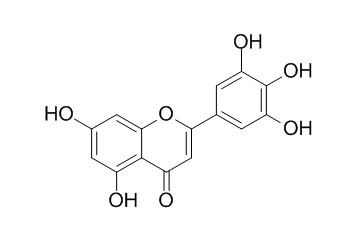Tricetin
Tricetin, a dietary flavonoid, inhibits proliferation of human breast adenocarcinoma mcf-7 cells by blocking cell cycle progression and inducing apoptosis. It possesses the anti-metastatic activity of osteosarcoma cells by transcriptionally repressing MMP-9 via p38 and Akt signaling pathways. Tricetin also may be a promising chemopreventive agent against human breast cancer.
Inquire / Order:
manager@chemfaces.com
Technical Inquiries:
service@chemfaces.com
Tel:
+86-27-84237783
Fax:
+86-27-84254680
Address:
1 Building, No. 83, CheCheng Rd., Wuhan Economic and Technological Development Zone, Wuhan, Hubei 430056, PRC
Providing storage is as stated on the product vial and the vial is kept tightly sealed, the product can be stored for up to
24 months(2-8C).
Wherever possible, you should prepare and use solutions on the same day. However, if you need to make up stock solutions in advance, we recommend that you store the solution as aliquots in tightly sealed vials at -20C. Generally, these will be useable for up to two weeks. Before use, and prior to opening the vial we recommend that you allow your product to equilibrate to room temperature for at least 1 hour.
Need more advice on solubility, usage and handling? Please email to: service@chemfaces.com
The packaging of the product may have turned upside down during transportation, resulting in the natural compounds adhering to the neck or cap of the vial. take the vial out of its packaging and gently shake to let the compounds fall to the bottom of the vial. for liquid products, centrifuge at 200-500 RPM to gather the liquid at the bottom of the vial. try to avoid loss or contamination during handling.
Int J Mol Sci.2020, 21(24):9369.
J Sci Food Agric.2023, 103(1):213-220.
Antioxidants (Basel).2023, 13(1):12.
Cancer Manag Res.2019, 11:483-500
Korean J Environ Agric.2018, 37(4):260-267
Cells.2021, 10(10):2633.
Int Immunopharmacol. 2020, 83:106403.
Exp Parasitol.2018, 194:67-78
Eur Rev Med Pharmacol Sci.2020, 24(9):5127-5139.
J Agric Food Chem.2021, 69(11):3496-3510.
Related and Featured Products
3',5-Dihydroxy-4',5',6,7-tetramethoxyflavone
Catalog No: CFN99214
CAS No: 111537-41-8
Price: Inquiry(manager@chemfaces.com)
5,7-Dihydroxy-3',4',5'-trimethoxyflavone
Catalog No: CFN96493
CAS No: 18103-42-9
Price: Inquiry(manager@chemfaces.com)
Corymbosin
Catalog No: CFN96498
CAS No: 18103-41-8
Price: Inquiry(manager@chemfaces.com)
Arteanoflavone
Catalog No: CFN96510
CAS No: 68710-17-8
Price: Inquiry(manager@chemfaces.com)
3',4',5,5',6,7-Hexamethoxyflavone
Catalog No: CFN70332
CAS No: 29043-07-0
Price: Inquiry(manager@chemfaces.com)
4'-Hydroxy-3',5,5',6,7,8-hexamethoxyflavone
Catalog No: CFN95407
CAS No: 85644-03-7
Price: $318/5mg
5'-Methoxynobiletin
Catalog No: CFN91940
CAS No: 6965-36-2
Price: Inquiry(manager@chemfaces.com)
Viscidulin III
Catalog No: CFN97488
CAS No: 92519-91-0
Price: $318/20mg
Viscidulin III tetraacetate
Catalog No: CFN97545
CAS No: 96684-81-0
Price: Inquiry(manager@chemfaces.com)
Viscidulin II
Catalog No: CFN92214
CAS No: 92519-93-2
Price: Inquiry(manager@chemfaces.com)
Journal of Agricultural & Food Chemistry, 2009, 57(18):8688-8695.
Tricetin, a dietary flavonoid, inhibits proliferation of human breast adenocarcinoma mcf-7 cells by blocking cell cycle progression and inducing apoptosis.[Reference:
WebLink]
This study is the first to investigate the anticancer effect of Tricetin in human breast adenocarcinoma MCF-7 cells.
METHODS AND RESULTS:
Results reveal that Tricetin inhibits MCF-7 cells by blocking cell cycle progression in the G2/M phase and inducing apoptosis. Cell cycle blockade is associated with increased activation of ataxia telangiectasia-mutated (ATM). Activation of ATM by Tricetin phosphorylated p53 at serine 15, resulting in increased stability of p53 by decreasing p53 and murine double minute-2 (MDM2) interaction. In addition, Tricetin-mediated G2/M phase arrest was also associated with decreases in the amounts of cyclin B, cyclin A, cdc2 and cdc25C, and increases in the phosphorylation of Chk2, cdc25C and cdc2. The specific ATM inhibitor caffeine significantly decreased Tricetin-mediated G2/M arrest by inhibiting the phosphorylation of p53 (serine 15) and Chk2. Tricetin-induced apoptotic cell death is associated with changes in the expression of Bax and Bak, decreasing levels of Bcl-2 and Bcl-X(L), and subsequently triggering the mitochondrial apoptotic pathway. In addition, pretreatment of cells with caspase-9 inhibitor blocked Tricetin-induced apoptosis, indicating that caspase-9 activation is involved in Tricetin-mediated MCF-7 cell apoptosis.
CONCLUSIONS:
These findings suggest that Tricetin may be a promising chemopreventive agent against human breast cancer.
Environmental toxicology, 2017, 32(7-8):2032-2040.
Tricetin inhibits human osteosarcoma cells metastasis by transcriptionally repressing MMP-9 via p38 and Akt pathways.[Reference:
WebLink]
Tricetin, a dietary flavonoid, has cytostatic properties and anti-metastasis activities in various cancer cells. However, the detailed impacts and underlying mechanisms of Tricetin on human osteosarcoma cell metastasis are still unclear.
METHODS AND RESULTS:
Here, the hypothesis that Tricetin possesses the anti‐metastatic effects on human osteosarcoma cells was tested. The effects of Tricetin on cell viability, motility, migration, and invasion in human osteosarcoma U2OS and HOS cells were investigated. Gelatin zymography, western blotting, polymerase chain reaction (PCR), and the luciferase assay were used to further explore the underlying mechanisms involved in anti‐metastatic effects in U2OS cells. Their results showed that Tricetin, up to 80 uM without cytotoxicity, attenuated U2OS and HOS cells motility, invasiveness, and migration by reducing matrix metalloproteinase (MMP)-9 enzyme activities. In U2OS cells, Tricetin decreased MMP-9 protein and mRNA expressions, which was confirmed by real-time PCR. Next, Tricetin reduced phosphorylation of p38 and Akt, but no effect on phosphorylation of ERK1/2 and JNK.
CONCLUSIONS:
In conclusion, Tricetin possesses the anti‐metastatic activity of osteosarcoma cells by transcriptionally repressing MMP-9 via p38 and Akt signaling pathways. This may be potentially useful as anti‐metastatic agents for osteosarcoma chemotherapy.



